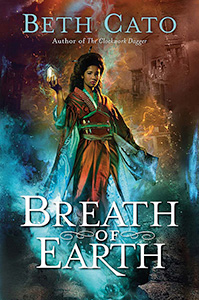Faren Miller Reviews Beth Cato
Breath of Earth, Beth Cato (Harper Voyager 978-0-06-242206-4, $14.99, 300pp, tp) August 2016.
 Breath of Earth by Beth Cato evokes the spirit of a time and place – San Francisco, at the dawn of the 20th century – in a world where magical beings and forces are an accepted part of human history, culture and daily life. When ‘‘the wealthy of Nob Hill journeyed to Sunday picnics in wagons teamed by iron-shackled pookas,’’ and geomancers fend off earthquakes from the bustling offices and training center of Earth Wardens, Cordilleran Auxiliary, where Ingrid Carmichael serves as personal secretary to Warden Sakaguchi, no one bats an eye.
Breath of Earth by Beth Cato evokes the spirit of a time and place – San Francisco, at the dawn of the 20th century – in a world where magical beings and forces are an accepted part of human history, culture and daily life. When ‘‘the wealthy of Nob Hill journeyed to Sunday picnics in wagons teamed by iron-shackled pookas,’’ and geomancers fend off earthquakes from the bustling offices and training center of Earth Wardens, Cordilleran Auxiliary, where Ingrid Carmichael serves as personal secretary to Warden Sakaguchi, no one bats an eye.
Too educated for her low social status (orphan, raised in the home where her mother had been Mr. Sakaguchi’s cook/housekeeper), too talented for her ‘‘inferior’’ sex (having inherited all the skills of the father she can’t remember, a brilliant geomancer), and looking nothing like the image conjured by her name (dark as her ambiguously ethnic dad), Ingrid’s a thorough misfit in a patriarchal world. But when the Auxiliary explodes, she and the warden – her employer, guardian, mentor, and surrogate father – survive only because her powers are greater than she knew.
While any book set in mid-April 1906 must lead to the monstrous quake Bay Areans call The Big One, Breath of Earth reimagines natural disaster. It precedes the cataclysm with murder (since most of San Francisco’s wardens died in that explosion) and threatens to trigger it with magic, while Ingrid strives to learn enough to foil the monstrous plot. Her adventures take some cues from entertainments of the era, evoking the dime novel’s melodrama, perils, and romance – there’s a hot guy here, and everyone has secrets – along with the wild interplay of tragicomedy in opera and operetta (Mr. Sakaguchi’s favorites, thanks to the City Opera).
Readers in search of steampunk and alt-history can find them here charged with magic: jump-starting invention and reworking world politics, as in this passing comment about ‘‘Japan’s many contributions to everyday American life… since the United Pacific had formed some forty years before during the brief War Between the States… [when] Japanese airship technology had granted Union forces a quick victory over the Confederacy.’’ Those ships run with the help of kermanite, a crystal activated by geomancy. It powered Roman dirigibles (the Dark Ages began when their source ran out), and the discovery of new supplies fueled the ongoing industrial revolution and new weapons of mass destruction.
Despite all the changes, ambitious nations and aging empires clash as ruthlessly as ever. Skewed versions of our wars create their own atrocities. China gets hit the hardest, in a dark background that surfaces in San Francisco’s Chinatown – despised by a multitude of racists from both sides of the United Pacific, cut off from city life, and torn apart by gang wars where opium is still the drug of choice. Its magical healers tend wounds that afflict major characters, over the course of the book.
With a strong cast and an unconventional approach to alternate history and magic (which casually mingle in Ingrid’s experience), this novel is a standalone according to the publisher. The bibliography of Cato’s ‘‘Clockwork Dagger series’’ does add two short stories and a novella to the original duology, so perhaps she’ll provide further glimpses of this extraordinary world.





